 With the winter fast approaching, consumers have already begun to stock up on warmer clothes. This has contributed towards consumer spending increasing faster in September than it has in the past 3 years. According to Visa Europe’s UK expenditure index, sales in August increased by 1.2pc, but in September they rose month-on-month by 3pc.
With the winter fast approaching, consumers have already begun to stock up on warmer clothes. This has contributed towards consumer spending increasing faster in September than it has in the past 3 years. According to Visa Europe’s UK expenditure index, sales in August increased by 1.2pc, but in September they rose month-on-month by 3pc.
But whilst sales on the high-street increased, sales on-line and over the telephone declined. It seems that the recent decrease in temperature is just what the retail sector ordered, as people took to the high streets.
Furthermore, recent improvements in consumer income, together with lower inflation and rising employment have all contributed towards a growth in spending. However, as consumer confidence remains at a relatively low level, it is unlikely that the winter will bring much of a change to growth in the economy. The Chief Economist at Markit said:
However, consumer confidence remains historically low as uncertainty about the economy and job security persists, suggesting that the bounce in spending seen in the third quarter could be as good as it gets for the foreseeable future.
 Although the lower temperature has caused a boost in consumption, once people have made their ‘investment’ in warmer clothes, retail spending may once again decline. Hence the above comment by Markit, which suggests that further sustained increases in consumer spending may still be some way off.
Although the lower temperature has caused a boost in consumption, once people have made their ‘investment’ in warmer clothes, retail spending may once again decline. Hence the above comment by Markit, which suggests that further sustained increases in consumer spending may still be some way off.
The following few articles look at the latest data on retail spending.
UK consumer spending ‘rose in September’ BBC News (5/10/12)
Consumer spending increases by 3pc The Telegraph (5/10/12)
Consumer spending increases by 3% The Press Association (5/10/12)
UK retail sales: what the analysts say Guardian (20/9/12)
Online sales and wet weather boost John Lewis Scotsman, Peter Ranscombe (5/10/12)
Questions
- Which factors typically affect consumer spending?
- Using a diagram, illustrate the impact of this increase in consumption on national output and the price level.
- Is it possible that a multiplier effect may occur with the August and September rise in retail sales?
- Why is consumer confidence remaining low? Which components of aggregate demand does it affect?
- Explain why (a) lower inflation, (b) the colder weather and (c) rising employment have caused consumer spending to rise.
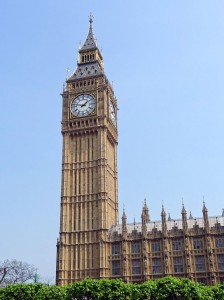 New data released on 25/7/12 by the Office for National Statistics showed that the UK economy shrank by a further 0.7% in the second quarter of 2012. This makes it the third quarter in a row in which GDP has fallen – and it is the steepest fall of the three. Faced with this, should the government simply maintain the status quo, or does it need to take new action?
New data released on 25/7/12 by the Office for National Statistics showed that the UK economy shrank by a further 0.7% in the second quarter of 2012. This makes it the third quarter in a row in which GDP has fallen – and it is the steepest fall of the three. Faced with this, should the government simply maintain the status quo, or does it need to take new action?
The construction sector declined the most steeply, with construction output 5.2% down on the previous quarter, which in turn was 4.9% down on the quarter previous to that. The output of the production industries as a whole fell by 1.3% and the service sector fell by 0.1%. (For a PowerPoint of the following chart, click here.)
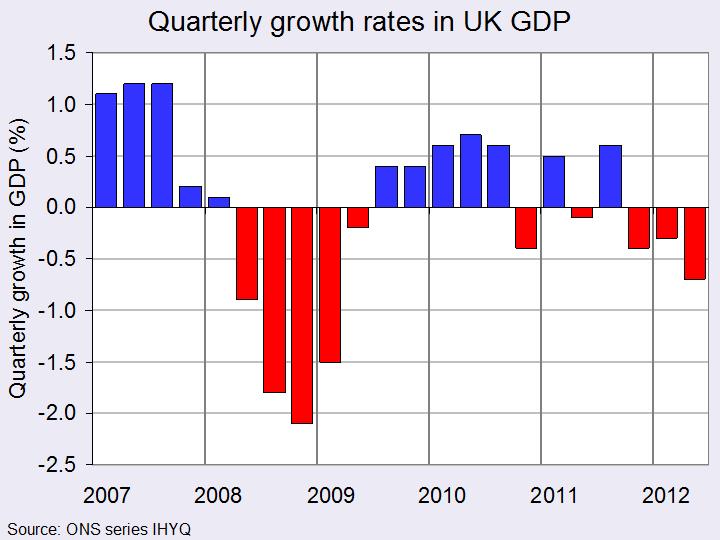
The immediate cause of the decline in GDP has been a decline in real aggregate demand, but the reasons for this are several. Consumer demand has fallen because of the squeeze on real wages, partly the result of low nominal pre-tax wage increases and partly the result of inflation and tax rises; the government’s austerity programme is holding back a growth in government expenditure; export growth has been constrained by a slowing down in the global economy and especially in the eurozone, the UK’s major trading partner; and investment is being held back by the pessimism of investors about recovery in the economy and difficulties in raising finance.
So what can be done about it?
Monetary policy is already being used to stimulate demand, but to little effect (see Pushing on a string. Despite record low interest rates and a large increase in narrow money through quantitative easing, broad money is falling as bank lending remains low. This is caused partly by a reluctance of banks to lend as they seek to increase their capital and liquidity ratios, and partly by a reluctance of people to borrow as individuals seek to reduce their debts and as firms are pessimistic about investing. But perhaps even more quantitative easing might go some way to stimulating lending.
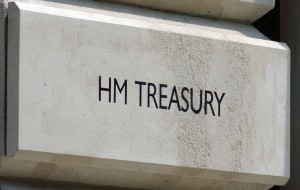
Fiscal policy might seem the obvious alternative. The problem here is that the government is committed to reducing the public-sector deficit and is worried that if it eases up on this commitment, this would play badly with credit rating agencies. Indeed, on 27/7/12, Standard & Poor’s, one of the three global credit rating agencies, confirmed the UK’s triple A rating, but stated that “We could lower the ratings in particular if the pace and extent of fiscal consolidation slows beyond what we currently expect.” Nevertheless, critics of the government maintain that this is a risk worth taking.
The following articles look at the causes of the current double-dip recession, the deepest and most prolonged for over 100 years. They also look at what options are open to the government to get the economy growing again.
Articles
Britain shrinks again The Economist (25/7/12)
Shock 0.7% fall in UK GDP deepens double-dip recession Guardian, Larry Elliott (25/7/12)
UK GDP figures: expert panel verdict Guardian, Frances O’Grady, Will Hutton, Sheila Lawlor, Vicky Pryce and John Cridland (25/7/12)
GDP shock fall: UK growth in 2012 ‘inconceivable’, warn economists The Telegraph, Angela Monaghan (25/7/12)
UK recession deepens after 0.7% fall in GDP BBC News (25/7/12)
UK economy: Why is it shrinking? BBC News (25/7/12)
UK GDP: A nasty surprise and a puzzle BBC News, Stephanie Flanders (25/7/12)
Tough choices for Mr Osborne BBC News, Stephanie Flanders (26/7/12)
David Cameron in pledge to control UK’s debt Independent, Andrew Woodcock and James Tapsfield (26/7/12)
David Cameron defends economic policies BBC News (26/7/12)
The GDP number is awful – and it’s the product of the Government’s amateur policies, not the euro crisis The Telegraph, Thomas Pascoe (25/7/12)
UK recession: have we heard it all before? Guardian, Duncan Weldon (25/7/12)
US economic growth slows in second quarter BBC News (27/7/12)
GDP data trigger debate on economy Financial Times, Norma Cohen and Sarah O’Connor (25/7/12)
Does weak UK growth warrant more QE? Financial Times (25/7/12)
The recession: Osborne’s mess Guardian editorial (25/7/12)
Data
Gross Domestic Product, Preliminary Estimate, Q2 2012 ONS (25/7/12)
Preliminary Estimate of GDP – Time Series Dataset 2012 Q2 ONS (25/7/12)
Questions
- What are the causes of the deepening of the current recession in the UK?
- Search for data on other G7 countries and compare the UK’s performance with that of the other six countries (see, for example, the OECD’s StatExtracts.
- Compare the approach of George Osborne with that of Neville Chamberlain in 1932, during the Great Depression.
- Does weak UK growth warrant more quantitative easing by the Bank of England?
- To what extent can fiscal policy be used to stimulate the economy without deepening the public-sector deficit in the short term?
- What is meant by ‘crowding out’? If fiscal policy were used to stimulate demand, to what extent would this cause crowding out?
 With the UK and eurozone economies in recession and with business and consumer confidence low, the Bank of England and the ECB have sprung into action.
With the UK and eurozone economies in recession and with business and consumer confidence low, the Bank of England and the ECB have sprung into action.
The ECB has cut its main refinancing rate from 1% to an all-time low of 0.75%. Meanwhile, the Bank of England has embarked on a further round of quantitative easing (QE). The MPC voted to inject a further £50 billion through its asset purchase scheme, bring the total to £375 billion since QE began in March 2009.
And it is not just in Europe that monetary policy is being eased. In Australia and China interest rates have been cut. In the USA, there have been further asset purchases by the Fed and it is expected that the Japanese central bank will cut rates very soon, along with those in Korea, Indonesia and Sri Lanka.
But with consumers seeming reluctant to spend and businesses being reluctant to invest, will the new money in the UK and elsewhere actually be lent and spent? Or will it simply sit in banks, boosting their liquidity base, but doing little if anything to boost aggregate demand?
And likewise in the eurozone, will a 25 basis point reduction in interest rates (i.e. a 0.25 percentage point reduction) do anything to boost borrowing and spending?
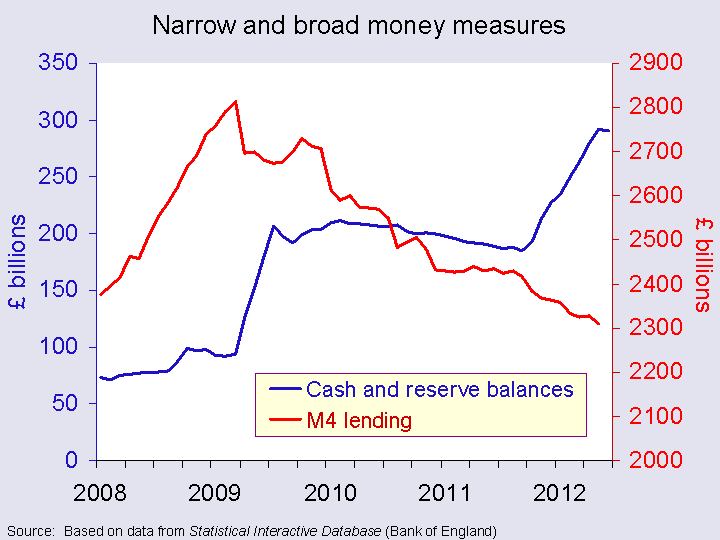 It is like pushing on a string – a term used by Keynesians to refer to the futile nature of monetary policy when people are reluctant to spend. Indeed the evidence over the past few years since QE started is that despite narrow money having risen massively, M4 lending has declined (see chart).
It is like pushing on a string – a term used by Keynesians to refer to the futile nature of monetary policy when people are reluctant to spend. Indeed the evidence over the past few years since QE started is that despite narrow money having risen massively, M4 lending has declined (see chart).
For a PowerPoint of the chart, click here.
The following articles look at the conundrum
Articles
Draghi-King Push May Mean Bigger Step Into Zero-Rate Era BloombergBusinessweek, Simon Kennedy (4/7/12)
QE and rate cut as central banks play stimulus card Independent, Ben Chu (6/7/12)
QE is welcome, but not enough Independent, Leader (6/7/12)
Interest rates cut to spur growth China Daily, Wang Xiaotian, Ding Qingfen and Gao Changxin (6/7/12)
Rate cuts shake global confidence Sydney Morning Herald, Eric Johnston, Clancy Yeates and Peter Cai (7/7/12)
Global Policy Easing Presses Asia to Cut Rates BloombergBusinessweek, Sharon Chen and Justina Lee (6/7/12)
Economic slowdown raises alarm in China, Europe Globe and Mail, Kevin Carmichael (5/7/12)
Bank of England sets sail with QE3 BBC News, Stephanie Flanders (5/7/12)
The twilight of the central banker The Economist (26/6/12)
The case for truly bold monetary policy Financial Times, Martin Wolf (28/6/12)
Questions
- Is the world economy in a liquidity trap?
- What advice would you give politicians around the world seeking to boost consumer and business confidence?
- Are we witnessing “The twilight of the central banker”? (See The Economist article above.)
- Explain the following extracts from the Martin Wolf article: “In a monetary system, based on fiat (or man-made) money, the state guarantees the money supply in the interests of the public. In normal times, however, actual supply is a byproduct of lending activities of banks. It is, in brief, the product of privately operated printing presses… In the last resort, the power to create money rests properly with the state. When private sector supply is diminishing, as now, the state not only can, but should, step in, with real urgency.”
- Should monetary policy in the UK be combined with fiscal policy in providing a stimulus at a time when the government can borrow ultra cheaply from the Bank of England? Does this apply to other governments around the world?
- Why did Asian share prices fall despite the stimulus?
 With the deepening euro crisis, the slide back into recession in many developed countries and the slowing down of fast-growing developing countries, such as China and India, confidence is waning.
With the deepening euro crisis, the slide back into recession in many developed countries and the slowing down of fast-growing developing countries, such as China and India, confidence is waning.
But just as pessimism increases, so too does uncertainty. The global economy is getting more and more difficult to forecast. So should economists give up trying to forecast? Should we rely on guesswork and hunch, or looking into crystal balls?
Bank of England representatives have been appearing before the Treasury Select Committee. And they have reiterated the consensus that things are getting more difficult to forecast. As Mervyn King said in his evidence:
There is just enormous uncertainty out there. I have no idea what is going to happen in the euro area.
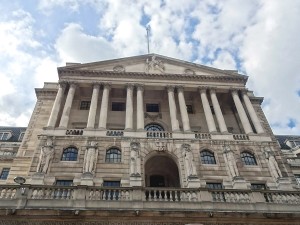 And this uncertainty is making people cautious, which, in turn, damages recovery. As Dr King went on to say:
And this uncertainty is making people cautious, which, in turn, damages recovery. As Dr King went on to say:
There is no doubt that with the additional uncertainty this year there’s evidence of people behaving in a very defensive way, being unwilling to invest and of course the most extreme example of that would be if we were to get to a liquidity trap where essentially the main assets people wanted to hold were claims on the central bank.
Part of the reason for the uncertainty about global growth prospects is uncertainty about what European leaders will decide about the future of the eurozone. Another is uncertainty about how people will respond to the uncertainty of others. But predicting how others will predict is very difficult as they will themselves be predicting what others will predict. This dilemma was observed by Keynes when observing how investors on the stock market behaved, all trying to predict what others will do, and is known as the Keynesian Beauty Contest dilemma (see also).
So are governments and central banks powerless to counteract the uncertainty and pessimism? Can they restore confidence and growth? Members of the Bank of England’s Monetary Policy Committee believe that further action can be taken to stimulate aggregate demand. Further quantitative easing and cuts in interest rates could help as, according to Dr King, we are not yet in a liquidity trap.
UK Economic Outlook Uncertain Amid Euro Zone Crisis – BOE NASDAQ, Ilona Billington (26/6/12)
BOE King: UK Not In Liquidity Trap; No Limit On QE Market News International (26/6/12)
BOE King: Unity On Loose Policy; Not Half Way Through Crisis Market News International (26/6/12)
Full Text Of BOE MPC Dale At Treasury Select Committee Market News International (26/6/12)
Recovery still five years away, Mervyn King warns The Telegraph, Philip Aldrick (26/6/12)
Governor pessimistic on recovery ShareCast, Michael Millar (26/6/12)
Bank’s King says ‘pessimistic’ about worsening economy BBC News (26/6/12)
UK economic outlook getting worse, warns Bank of England Guardian, Phillip Inman (26/6/12)
Questions
- Why is it worth economists forecasting, even if those forecasts rarely turn out to be totally accurate?
- Why is it particularly difficult in current circumstances to forecast the state of the macroeconomy 12 months hence – let alone in two or three years?
- In what ways is the global macroeconomic situation deteriorating? What can national governments do about it?
- What limits the effectiveness of government action to deal with the current situation?
- What is meant by the liquidity trap? Are we close to being in such a situation today?
- Explain what is meant by the Keynesian Beauty Contest? How is this relevant today in explaining economic uncertainty and the difficulty of forecasting the economy?
 At the Mansion House dinner on 15 June, the Chancellor, George Osborne, and the Governor of the Bank of England, Sir Mervyn King, announced a new monetary policy initiative to increase bank credit. The idea is to stimulate borrowing by both firms and households and thereby boost aggregate demand.
At the Mansion House dinner on 15 June, the Chancellor, George Osborne, and the Governor of the Bank of England, Sir Mervyn King, announced a new monetary policy initiative to increase bank credit. The idea is to stimulate borrowing by both firms and households and thereby boost aggregate demand.
There are two parts to the new measures:
1. Funding for lending. The aim here is to provide banks with cheap loans (i.e. at below market rates) on condition that they are used to fund lending to firms and households. Some £80 billion of loans, with a maturity of 3 to 4 years, could be made available to banks under the scheme. The details are still being worked out, but the scheme could work by the Bank of England supplying Treasury bills to the banks in return for less secure assets. The banks could then borrow against these bills in the market in order to lend to customers.
2. Providing extra liquidity to banks through six-month repos. The Bank of England will begin pumping up to £5bn a month into the banking system to improve their liquidity. This is an activation of the ‘Extended Collateral Term Repo Facility’ (see also), which was created last December, to provide six-month liquidity to banks against a wide range of collateral.
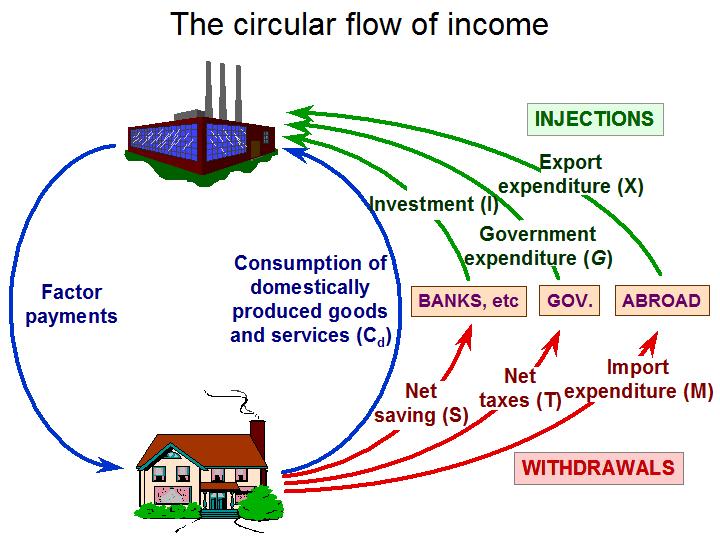 But whilst it is generally accepted that a lack of borrowing by firms and households is contributing to the slowdown of the UK economy, it is not clear how the new measures will solve the problem.
But whilst it is generally accepted that a lack of borrowing by firms and households is contributing to the slowdown of the UK economy, it is not clear how the new measures will solve the problem.
In terms of the supply of credit, banks have become more cautious about lending because of the increased risks associated with both the slowdown in the UK economy and the euro crisis. They claim that the issue is not one of a shortage of funding for lending, but of current uncertainties. They are thus likely to remain reluctant to lend, despite the prospect of extra loans from the Bank of England.
In terms of the demand for credit, both businesses and consumers remain cautious about borrowing. Even if bank loans are available, firms may not want to invest given the current uncertainties about the UK, eurozone and world economies. Consumers too may be reluctant to borrow more when people’s jobs may be at stake or at least when there is little prospect of increased wages. Even if banks were willing to lend more, you cannot force people to borrow.
Britain fights euro zone threat with credit boost Reuters, Matt Falloon and Sven Egenter (14/6/12)
Debt crisis: emergency action revealed to tackle ‘worst crisis since second world war’ Guardian, Larry Elliott, Jill Treanor and Ian Traynor (14/6/12)
Q&A: Funding for lending scheme Financial Times, Norma Cohen (15/6/12)
Bank lending plan: How will it work? BBC News (15/6/12)
Bank of England’s loans to high street banks start next week Guardian, Phillip Inman (15/6/12)
 Mervyn King: Bank of England and Treasury to work together The Telegraph (15/6/12)
Mervyn King: Bank of England and Treasury to work together The Telegraph (15/6/12)
 Bank of England offers £80bn loans Channel 4 News, Sarah Smith (15/6/12)
Bank of England offers £80bn loans Channel 4 News, Sarah Smith (15/6/12)
Bank funding scheme plans unveiled Independent, Holly Williams (15/6/12)
Banking: King hits panic button Independent, Ben Chu (15/6/12)
Bankers raise doubts on credit scheme Financial Times, Patrick Jenkins and Sharlene Goff (15/6/12)
We should not pin our hopes on Britain’s plan A-plus Financial Times, Martin Wolf (15/6/12)
Throwing money at banks won’t solve economic crisis, Ed Balls says Guardian, Patrick Wintour (15/6/12)
UK lending plan faces risk of low take-up BloombergBusinessweek, Robert Barr (15/6/12)
Will Bank of England’s new lending schemes work? BBC News, Robert Peston (15/6/12)
Bank and Treasury’s plan A-plus for UK BBC News, Stephanie Flanders (15/6/12)
Questions
- How would the schemes incentivise banks to lend more?
- Explain what is meant by the Extended Collateral Term Repo Facility. How similar is it to the long-term repo operations of the ECB (see the news item More bank debt to ease bank debt)?
- What factors are likely to determine the take-up of loans from banks?
- Will the new arrangements have any implications for taxpayers? Explain.
- To what extent are fiscal and monetary policy currently complementary?
- What is the significance of calling the new measures ‘Plan A-plus’? What would ‘Plan B’ be?
 With the winter fast approaching, consumers have already begun to stock up on warmer clothes. This has contributed towards consumer spending increasing faster in September than it has in the past 3 years. According to Visa Europe’s UK expenditure index, sales in August increased by 1.2pc, but in September they rose month-on-month by 3pc.
With the winter fast approaching, consumers have already begun to stock up on warmer clothes. This has contributed towards consumer spending increasing faster in September than it has in the past 3 years. According to Visa Europe’s UK expenditure index, sales in August increased by 1.2pc, but in September they rose month-on-month by 3pc. Although the lower temperature has caused a boost in consumption, once people have made their ‘investment’ in warmer clothes, retail spending may once again decline. Hence the above comment by Markit, which suggests that further sustained increases in consumer spending may still be some way off.
Although the lower temperature has caused a boost in consumption, once people have made their ‘investment’ in warmer clothes, retail spending may once again decline. Hence the above comment by Markit, which suggests that further sustained increases in consumer spending may still be some way off.








